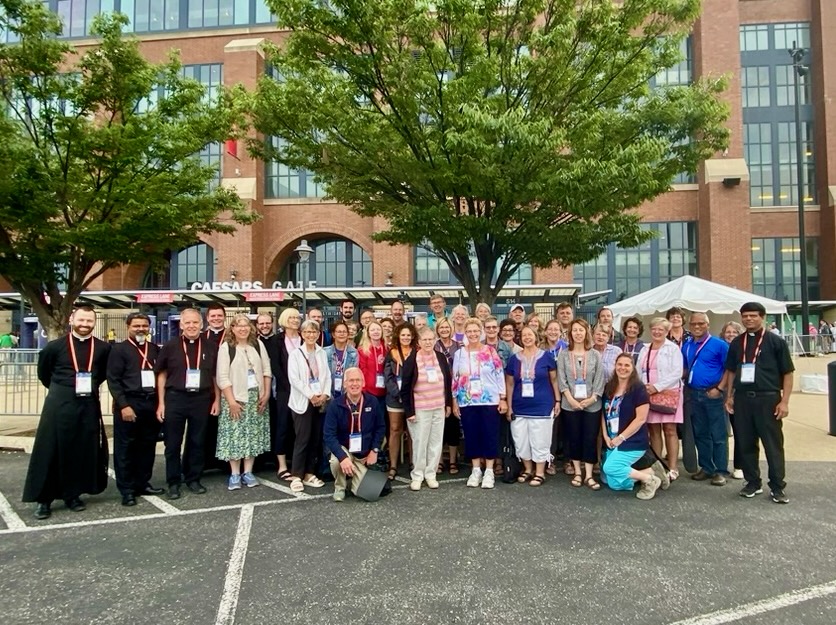
Sixty pilgrims from the Diocese of Superior traveled to Indianapolis in July to gather with around 60,000 fellow Catholics for the National Eucharistic Congress. This issue includes coverage of the speakers and events provided by the Milwaukee Catholic Herald. (Photo courtesy Diocese of Superior)
Kathleen McGillis Drayna
Catholic Herald Staff Writer
He is here.
In a powerful moment, those three words came on screens before tens of thousands of Catholics gathered in an Indianapolis sports stadium for the opening ceremony of the National Eucharistic Revival.
“That was very powerful,” said Fr. Dan Janasik, one of the leaders of the Archdiocese of Milwaukee pilgrimage to the congress. “That, I think, set the tone for the whole night.”
Tens of thousands of happy, energized Catholics greeted and worshiped the Body of Christ in the Eucharist during the 10th National Eucharistic Congress that began Wednesday, July 17.
He is here.
The congress turned Lucas Oil Stadium into a Catholic cathedral of sorts, with Catholic sights, sounds and smells.
Preceding that moment, small groups of 65-day perpetual pilgrims jubilantly presented icons of four saints that accompanied them on the routes named for those saints. These included the Marian Route that passed through the Archdiocese of Milwaukee in June.
Following that moment, Bishop Andrew Cozzens of Crookston, Minnesota, led more than 30 minutes of Eucharistic Adoration after he processed into the stadium with Jesus in the Eucharist in a large monstrance. Cozzens, leader of the three-year National Eucharistic Revival, concluded the final procession of the National Eucharistic Pilgrimage.
“We want you to transform us into true disciples, missionary disciples,” Cozzens said. “Lord, we know this revival has to begin with us. Lord, we desire deeper conversion, deeper repentance. We surrender our lives to you.”
He prayed for unity and peace in our country, Church and world. “Change our hearts, Lord. Make them like your heart, Lord.”
At times, all present fell silent in private prayer, while worship and praise sing-alongs stood out at other times. A sophisticated video backdrop celebrated highlights of the Eucharistic pilgrimage and offered other eye-catching imagery, as well as provided close-ups of major speakers.
The national congress, the first such event held in 83 years, drew Catholics of all ages and backgrounds from around the nation.
Auxiliary Bishops Jeffrey R. Haines and James T. Scheurman are leading the archdiocese pilgrimage of about 240 people along with Fr. Janasik, Fr. Juan Camacho and Fr. Joseph Heit.
“We are all broken. Tonight, our Lord met us in that brokenness and invited us to receive his love and healing presence,” said Fr. Heit. “There is hope, and we witnessed it tonight in the Eucharist and in the thousands of Catholics gathered as this historic moment in the Church in the United States.”
The congress is a first in some ways for Bishop Schuerman.
“This is certainly the largest religious event that I have ever been a part of. It will be a new experience and an exciting one,” he said. “The Spirit can go to work in the lives of the people who attend.”
Bishop Schuerman described the pilgrims as “people of faith who are going to experience a renewal and renovation of their own faith to take back and share.”
Even for the pilgrimage leaders, he said, “basically, it’s going to be an adventure for all of us.”
More than 50,000 people are expected to attend the five-day congress.
Bishop Scheurman expects the massively attended liturgies as well as talks by major Catholic speakers to be inspiring. The large Eucharistic procession planned for Saturday, July 20, in downtown Indianapolis will be “a wonderful show of faith.”
At the same time, Bishop Haines noted, “It’s not just an event, it’s a movement.” The third year of the revival after the Congress is designated as a year of sending forth disciples to make more disciples. “This isn’t the end — it’s a formational journey,” Bishop Haines said.
Attendees include more than 200 bishops and cardinals, 1,000 priests and about 5,000 attendees under age 18, and 3,000 ages 18-25.
